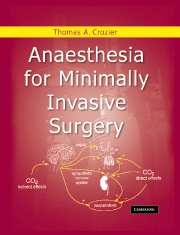Book contents
- Frontmatter
- Contents
- Preface
- Foreword
- Acknowledgements
- 1 Introduction
- 2 Physiology
- 3 Preparing and positioning for laparoscopic surgery
- 4 Monitoring
- 5 Anaesthesia for laparoscopic surgery
- 6 Complications and contraindications of laparoscopic surgery
- 7 Post-laparoscopy pain and pain relief
- 8 Laparoscopic bariatric surgery
- 9 Minimally invasive thoracic surgery
- 10 Laser surgery of the upper aerodigestive tract
- 11 Minimally invasive neurosurgery
- Index
10 - Laser surgery of the upper aerodigestive tract
Published online by Cambridge University Press: 21 October 2009
- Frontmatter
- Contents
- Preface
- Foreword
- Acknowledgements
- 1 Introduction
- 2 Physiology
- 3 Preparing and positioning for laparoscopic surgery
- 4 Monitoring
- 5 Anaesthesia for laparoscopic surgery
- 6 Complications and contraindications of laparoscopic surgery
- 7 Post-laparoscopy pain and pain relief
- 8 Laparoscopic bariatric surgery
- 9 Minimally invasive thoracic surgery
- 10 Laser surgery of the upper aerodigestive tract
- 11 Minimally invasive neurosurgery
- Index
Summary
The upper aerodigestive tract is a collective term designating the region from the nasal passages to the level of the bronchi. It encompasses the oropharynx and hypopharynx, the tongue, epiglottis and glottis, the larynx and trachea, the oral cavity and the nasal passages. Any and all of these structures can be approached by laser surgery, but the most common localization of pathological processes is the larynx.
Lasers were introduced into the treatment of laryngeal lesions in the early 1970s by Jako and Strong. Surgeons such as Burian in Austria, Frèche in France, and Oswal and Howard in the UK helped to establish the technique in Europe. Pioneers such as Wolfgang Steiner in Germany were instrumental in taking the technique to new frontiers so that nowadays nearly every pharyngolaryngological operation, including curative and palliative resection of bulky tumours, can be performed transorally with the laser. Management of anaesthesia for these procedures has been a challenge since their very introduction. The interdependence between anaesthesia and surgery for the development of the field is illustrated by the fact that studies on the best methods of anaesthesia coincided with the surgical reports and were even co-authored by surgeons. Further research helped to optimize working conditions for the surgeon while providing the patient with a greater degree of perioperative safety and comfort.
The use of lasers as a surgical cutting instrument provides an elegant and minimally invasive approach to surgery.
- Type
- Chapter
- Information
- Anaesthesia for Minimally Invasive Surgery , pp. 145 - 176Publisher: Cambridge University PressPrint publication year: 2004



